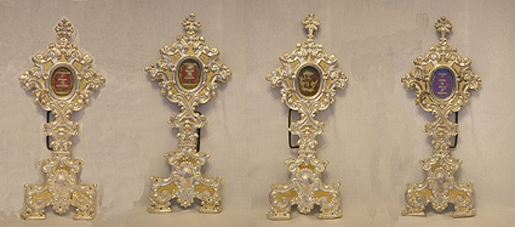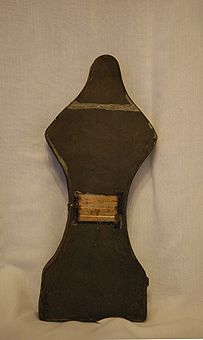The piece of the month of March 2007
AZPILIKUETA RELIQUARIES
Ignacio Miguéliz Valcarlos
Chair of Navarrese Heritage and Art
A set of four reliquaries carved in silver plate in its color and gilded on a wooden core. They have a triangular mixtilinear base, on a molded plinth sit two legs in the form of vegetal scrolls that frame in the center a large oval mirror of profile mixtilinear, curved lines at the bottom and straight at the top, framed by ces and sinuous rockeries, in a rich play of curves and countercurves, which in the lower part, and as a hanging skirt of the base, continues with another mixtilinear motif framed by ces and vegetal elements. In the upper part of the base, and as an element of transition to the shaft, there are two volutes formed by "ces" and rockeries, similar to those that form the lower part of the base and those that frame the central mirror of the same. Mixtilinear shaft of broken and sinuous contour, whose profile is reminiscent of the usual inverted periform volumes in the knots of the shaft pieces in the silverware of this time, and that gives way to the ostensory, with oval virile of profile molded, framed by a rich glory of broken contour, of great movement, composed by caes, vegetal elements and rocailles, all finished off by a vegetal cross. The piece has a central axis with a vertical path that divides the work into two symmetrical halves.
The four reliquaries are covered with a rich decoration, which breaks the architectural structure of the same, with broken and sinuous movements, in a rich game of curves and countercurves, which is articulated by means of ces, composed of flat ribbons of different volumes, vegetal elements and rocailles, which completely cover the profile of the pieces, as well as framing different motifs at the base, knot and monstrance. All this is completed with a beautiful chromatic effect by combining the silver in its color, for the decorative elements and the structural lines of the pieces, and the golden silver in which the smooth backgrounds of the four reliquaries are made, constituting geometric mixtilinear frames on which the ornamental elements are cut out.

Azpilikueta Reliquaries
They respond to the typology of multiple reliquaries, since in the interior of the viriles the relics of several saints are conserved, thus in the first of them are the relics of St. Francis Xavier, St. Ignatius of Loyola and St. Aloysius Gonzaga, in the second one those of San Martín de Tours, San Andrés Apóstol and San Esteban protomártir, in the third one the Lignum Crucis, Santa María Magdalena and Santa Bárbara, and finally in the fourth one the relics of San José, of the Veil of the Virgin Mary and of San Joaquín are conserved. It is not surprising the existence of the relics of the three Jesuit saints, especially that of San Francisco Javier, since the mother of this saint, Doña María Azpilkueta was a native of this town.
These four works arrived at the parish of Azpilkueta in the third quarter of the 18th century, when Esteban Yarnoz, a native of Muruarte de Reta and from Labiano, was the rector of the church, President attachment from 1758 to 1776, when he became the rector of plenary session of the Executive Council until 1791, when he was replaced by Pedro Felipe de Córdoba, a native of Azpilkueta.
None of these four reliquaries have stamped punches of locality or artist, although they follow models elaborated in Rome throughout the 18th century, which were imitated in several peninsular centers, such as Zaragoza or Cordoba, and of which similar works exist in different Hispanic churches. Although they are very showy pieces, their elaboration is not costly, as they are works made of silver plate on a wooden core, since they were largely created for sale and import to people who came to Rome, either on pilgrimage or for official reasons, who acquired them as gifts to their parishes of origin, which meant that the demand and export of relics was very numerous.

Box
In the 16th century, devotion to relics experienced an important boom, motivated in part by the denial of relics and saints by Protestants. Because of this, in the XXV session of the Council of Trent it was established that "the sacred bodies of the saints and martyrs and of the others who live with Christ ... should be venerated, so that those who affirm that the relics of the saints should not be venerated and honored ... should be absolutely condemned". This fact was also favored by the rediscovery in 1578 of the Roman catacombs, while in Spain the devotion for the relics experienced by the kings of the house of Austria, the religious orders, especially the Jesuits, and in imitation of them the society in general, it motivated that the Spanish temples gathered some nourished reliquaries, especially from Felipe II, who gathered a great collection in El Escorial, competing among them for the acquisition of relics, especially of those more popular saints or linked in some way with the church that was going to keep them. Subsequently, and after the catacombs were put back into effect in Rome in the first half of the 18th century, and the massive contribution of remains of those who were considered to be the first Christian martyrs, the cult of relics experienced a new boom, as witnessed by these reliquaries sent to the parish of Azpilkueta. The gift or donation of these relics can be related to those made by other people such as Don Pascual Beltrán de Gayarre, archdeacon of the Chamber of the Cathedral of Pamplona, who in 1729 sent the mummified bodies of Saint Columba, Saint Deodata, Saint Innocent and Saint Fidel to the said temple; or the silver filigree reliquaries, also containing several relics in their teakwood, as in the case of those of Azpilkueta, sent to his native parish of Lazcano in 1743 by Don Ambrosio de Albisu, canon of the cathedral of Pamplona and prior of the monastery of Nuestra Señora de Velate.
bibliography:
GIANNANTIEMPO LOPEZ, M., Ori e argenti. Capolavori di Oreficeria sacra nella provincia di Macerata, Macerata , 2001, pp. 45, 197, 199, 199, 204, 206, 228, 230, 248 and 250.
GOÑI GAZTAMBIDE, J., Historia de los Obispos de Pamplona. S.XVIII, Volume VII, Pamplona, EUNSA, 1989, pp. 270-273.
MIGUÉLIZ VALCARLOS, I., "Aportaciones al estudio de la platería barroca en Gipuzkoa: Una custodia siciliana en Lazkao", in Revisión del Arte Barroco. Ondare. nº 19, Cuadernos de artes plásticas y monumentales, Eusko Ikaskuntza-Sociedad de programs of study Vascos, San Sebastián, 2000, pp. 601-609.
MIGUÉLIZ VALCARLOS, I., "Relicario de San Francisco Javier", in FERNÁNDEZ GRACIA, R. (coord.), San Francisco Javier y las Artes. El poder de la imagen, Gobierno de Navarra, Pamplona, 2006, pp. 414-415.
MIGUÉLIZ VALCARLOS, I., El Arte de la Platería en Gipuzkoa. Siglos XV - XVIII, Diputación Foral de Gipuzkoa, San Sebastián, (in press).
PÉREZ GRANDE, M., La platería en la Colegiata de Talavera de la Reina, Diputación Provincial de Toledo, Toledo, 1985, pp. 129-131, Lám. XXX.
